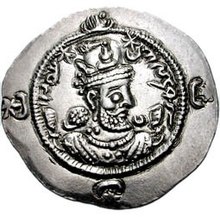| Hormizd IV 𐭠𐭥𐭧𐭥𐭬𐭦𐭣 | |
|---|---|
| King of Kings of Iran and non-Iran[a] | |
 | |
| Shahanshah of the Sasanian Empire | |
| Reign | 579–590 |
| Predecessor | Khosrow I |
| Successor | Bahram Chobin (rival king) Khosrow II (successor) |
| Born | c. 540 |
| Died | June 590 (aged 50) Ctesiphon |
| Spouse | Unnamed Ispahbudhan noblewoman Unnamed Christian noblewoman |
| Issue | Khosrow II Unnamed daughter |
| House | House of Sasan |
| Father | Khosrow I |
| Mother | Khazar princess |
| Religion | Zoroastrianism |
Hormizd IV (also spelled Hormozd IV or Ohrmazd IV; Middle Persian: 𐭠𐭥𐭧𐭥𐭬𐭦𐭣) was the Sasanian King of Kings of Iran from 579 to 590. He was the son and successor of Khosrow I (r. 531–579) and his mother was a Khazar princess.
During his reign, Hormizd IV had the high aristocracy and Zoroastrian priesthood slaughtered, whilst supporting the landed gentry (the dehqan). His reign was marked by constant warfare: to the west, he fought a long and indecisive war with the Byzantine Empire, which had been ongoing since the reign of his father; and to the east, the Iranian general Bahram Chobin successfully contained and defeated the Western Turkic Khaganate during the First Perso-Turkic War. It was also during Hormizd IV's reign that the Chosroid dynasty of Iberia was abolished. After negotiating with the Iberian aristocracy and winning their support, Iberia was successfully incorporated into the Sasanian Empire.
Jealous of Bahram's success in the east, Hormizd IV had him disgraced and dismissed, which led to a rebellion led by Bahram, which marked the start of the Sasanian civil war of 589–591. Another faction, led by two other dissatisfied nobles, Vistahm and Vinduyih, had Hormizd IV deposed and killed, and elevated his son Khosrow II as the new king (shah).
Hormizd IV was noted for his religious tolerance, declining appeals by the Zoroastrian priesthood to persecute the Christian population of the country. Contemporary sources generally considered him to be a tyrannical figure, due to his policies. Modern historiography presents a milder view of him, and considers him a well-meaning ruler who strived to continue his father's policies, albeit overambitiously.
Cite error: There are <ref group=lower-alpha> tags or {{efn}} templates on this page, but the references will not show without a {{reflist|group=lower-alpha}} template or {{notelist}} template (see the help page).